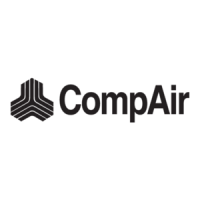4. Design and functioning
23
4.3 Oil circuit
The oil flows from the pressure reservoir (- 6 -) into the
oil thermostat (- 16 -). With oil temperatures < 55 °C
(131 °F) the oil flows via the by-pass of the oil cooler
directly into the oil filter (- 17 -) and is then injected into
the screw compressor (- 4 -).
With oil temperatures of between 55 °C (131 °F) and
70 °C (158 °F) the oil flow is divided and fed into the oil
cooler (- 15 -) and the by-pass.
With oil temperatures above 70 °C (158 °F) the entire
oil flow is directed via the oil cooler through the oil filter
into the screw compressor.
The oil separated by the oil separator element
(- 7 -) is fed through an oil scavage line to the screw
compressor.
The entire oil circulation is based on a differential
pressure in the system. Considering the pressure
difference of approx. 2 bar (29 PSI) within the oil circuit,
the oil is then injected into the screw compressor with
approx. 8 bar (116 PSI) at a reservoir pressure of e.g.
10 bar (145 PSI).
When the screw compressor is in the off-load mode, a
sufficiently high pressure differential and thus the
required oil injection quantity is achieved owing to the
fact that when the intake regulator (- 2 -) is closed, a
vacuum pressure occurs in the intake connection and at
the place of injection.
Excess pressure of approx. 1.5 bar (22 PSI) (off-load
pressure) is produced in the pressure reservoir at the
same time.
4.4 Air circuit
The intake air passes through the intake filter (- 1 -) and
the intake regulator (- 2 -) into the screw compressor
(- 4 -). During the compression process, the intake air is
cooled via the injected oil. The developed air/oil mixture
flows tangentially into the pressure reservoir (oil
reservoir) (- 6 -). After pre-separation and subsequent
fine separation by the separator element (- 7 -), the
compressed air with a low oil content is fed via the
minimum pressure valve (- 12 -) and the air cooler
(- 14 -) into the consumer network.
4.5 System control
(See also operating instructions for the compressor
control DELCOS XL)
Standstill of the system
• If the plant is shut down, the suction controller (- 2 -)
is closed by a pressure spring at the adjusting
cylinder (- 2.1 -).
• The solenoid valve (- 23 - (Y1)) is deenergised.
• The oil separator vessel is released via valve
(- 24 -) to atmospheric pressure.
• The cooling water solenoid valve (-33-(Y6)) is
closed in a deenergised state (only Lxx W – water-
cooled units)
Starting the system
• The motor starts up in the Y-mode.
• The cooling water solenoid valve (-33-(Y6)) is
supplied with power and opens (Lxx W only).
• The intake regulator is closed.
• The compressor aspires a certain amount of air
through an adjustable choke valve (bypass valve)
(- 2.4 -). Pressure builds up in the pressure vessel.
• The oil supply of the screw compressor takes place
through a drop in pressure between the pressure
vessel and the injection spot in the screw
compressor.
• If the drive motor is switched over to Δ operation,
the magnetic valve switches over (-23-(Y1) since it
is supplied with current.
• The air circulated in the system streams over the
solenoid valve (-23- (Y1)) in the upper control area
of the operating cylinder (-2.1-). The blow off valve
(-24-) is closed. The lower control space of the
adjusting cylinder is ventilated.
• The choke valve (- 2.2 -) in the intake regulator
(- 2 -) opens.
• At a reservoir pressure of approx. 4.5 bar (65 PSI)
the pressure holding and check valve (- 12 -) opens.
• Compressed air is now delivered into the consumer
network.
• The system is now in load running mode.

